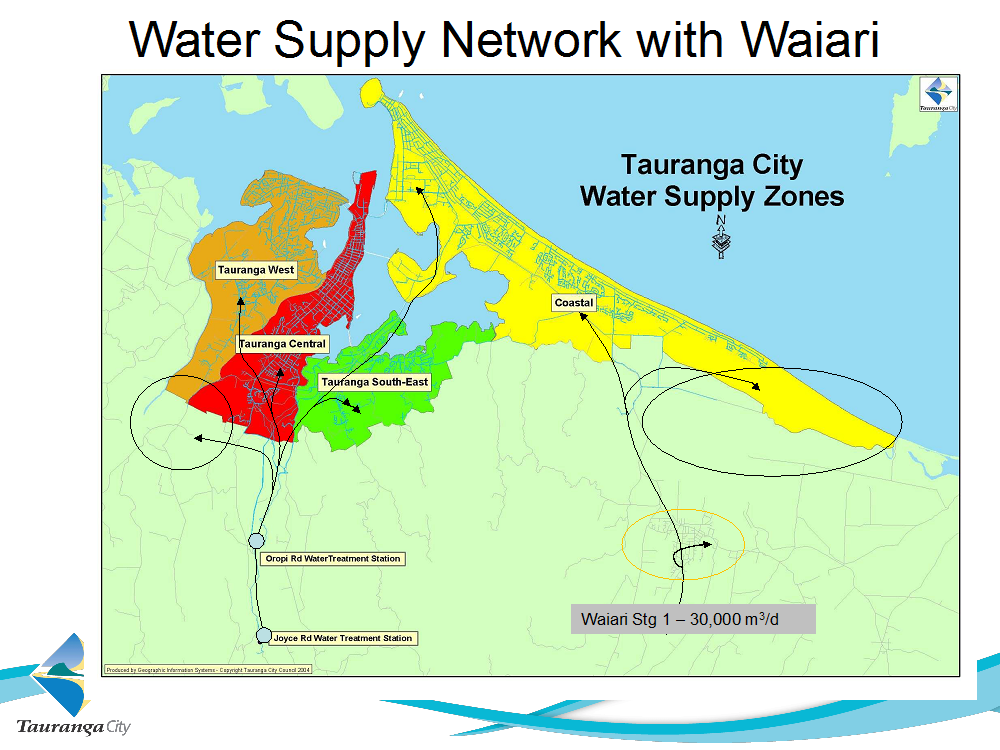Waiari Water Supply Scheme
The Waiāri Water Supply Scheme is designed to help meet the future water supply needs of Tauranga and the wider Western Bay of Plenty.
What is the Waiāri Water Supply Scheme?
The Waiāri Water Supply Scheme involves developing a new water abstract facility on the Waiāri Stream, a water treatment plant in No.1 Road, Te Puke, and an underground water pipeline from the plant to Papamoa.
The plant will mainly service the Papamoa coastal strip/Te Tumu growth areas and provide a backup for Western Bay of Plenty District Council's Te Puke water supply.
Construction is expected to be completed in 2021.
Why do we need a new water supply?
Increased demand in the coastal strip
The coastal strip from Mount Maunganui to Papamoa is predicted to be Tauranga's highest growth area over the next 50 years. We expect Papamoa's population to increase threefold from the present 12,300 over the next 30 years. Te Puke's population is also expected to grow steadily.
Tauranga currently has two water treatment plants: one at Oropi and one at Joyce Road. Opened in the 1950s and upgraded in 1997, these plants provide Tauranga with water, but they won't be able to provide for the growth in population in our coastal communities.
Security of Supply for Western Bay of Plenty
Tauranga City Council and Western Bay of Plenty District Council and are working together to protect the sub-regional water supply for the future.
Te Puke and other communities in the surrounding area are currently supplied by groundwater bores. The Waiāri plant will ease pressure on these supplies and ensure future increases in water demand can be met.
News
Construction on the Waiari Pipeline and intake commenced in 2019. Please see the project page on Tauranga City Council's website for the latest information about the project.
Frequently asked questions
Which areas will the water treatment plant supply?
The Waiāri Water Supply Scheme will mainly service the Papamoa coastal strip/Te Tumu growth areas, and also provide a backup for the groundwater bores that service the Te Puke area.
Why the Waiāri Stream?
We explored a number of different options to increase Tauranga's water supply, including groundwater bores and 10 streams in the Western Bay. We chose the Waiāri Stream because of its year-round stream flow, water quality and proximity to our fast-growing coastal regions.
How much water will be abstracted from the Waiāri Stream?
Up to 60,000m^3 per day.
Bay of Plenty Regional Council is also reviewing the amount of water that will be abstracted from the stream, to ensure we maintain water quality, and the waterway can still support wildlife and naturally recharge.
How will you protect the Waiāri Stream?
We've been undertaking ecological monitoring since the resource consent was granted in 2010, and will continue to keep a watchful eye on the stream's chemical and biological health. We'll also plant alongside the stream to prevent erosion.
How will the scheme be funded?
The project will cost Tauranga City Council $115 million, which is being funded in the first instance by an interest-free government infrastructure loan. We'll be able to repay the loan once we receive revenue from new houses, development contributions and house rates.
Will Western Bay of Plenty District Council be using this water for Te Puke and other landowners in the area?
Tauranga City Council and Western Bay of Plenty Council have a joint resource consent to take water from the Waiāri Stream. Western Bay of Plenty District Council currently gets its water supply from groundwater bores around the District.
At some stage in the future, they will need to use the water from the Waiāri Water Supply Scheme. The timing of this will depend on demand and growth int he area. The resource consent for the water abstracted from the Waiāri Stream allows for 25 per cent of the water to go to the Western Bay of Plenty district.
What does the project consist of?
The project consists of the following, which are currently in various stages of design:
- A water abstract facility on the Waiāri Stream
- raw water pipelines feeding water from the abstraction point to the treatment plant
- a microfiltration water treatment plant
- a treated water reservoir
- a waste/residuals handling plant
- various pipelines from the plant to distribute the water to service reservoirs
Where is the pipeline going?
The water will flow from the plant through a high-pressure underground pipeline down No. 1 Road, through Te Puke and out to Poplar Lane reservoir. Pipes from here will take the water to the eastern reservoir and Papamoa.
There will be around 15 kilometres of underground pipelines, between Te Puke and Papamoa to Welcome Bay Road.
What about the local iwi?
Iwi relationships with the river, water quality and quantity and ecosystem health are important in our plans for the increasing population in the Papamoa East area.
The project recognises the intristic relationship tangata whenua have with the Waiāri by partnering with iwi through the Waiāri Kaitiaki Advisory Committee.


